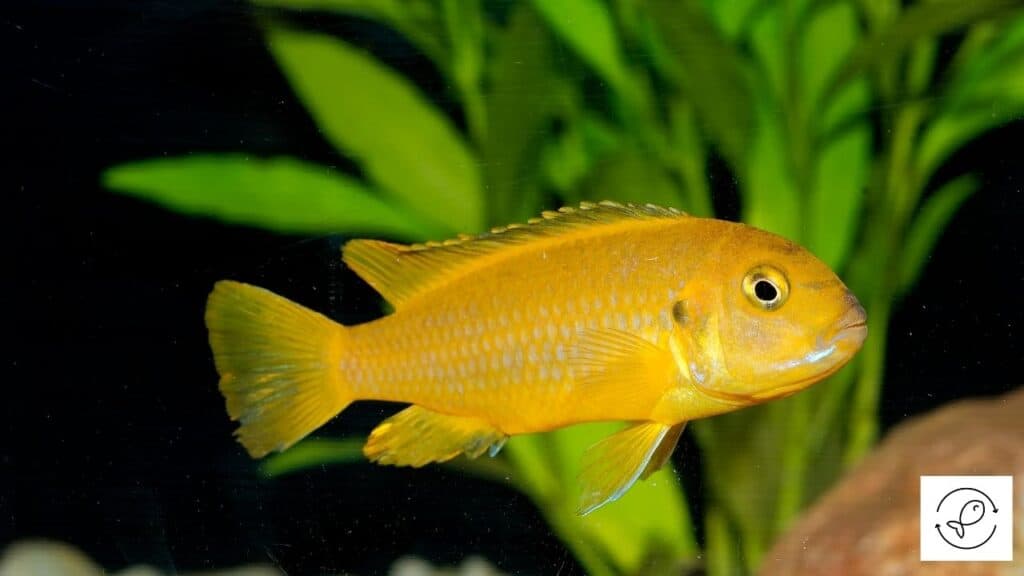Cichlids are one of the most colorful and diverse fish species.
They’re known for their stunning visual appearance and social behavior, making them popular amongst aquarium enthusiasts.
Most species of cichlids are aggressive.
So aquarists need to be careful while keeping, breeding, and selecting tankmates for them.
Let’s learn about cichlids in more detail now.
Cichlids Species Overview
Cichlids are one of the most diverse groups of colorful fish species that inhabit the freshwater lakes of Africa and river basins of South and Central America.
African cichlids are the most common type of cichlids found worldwide.
They typically live in the freshwater lakes of Africa, namely Lake Malawi, Lake Victoria, and Lake Tanganyika.
South American cichlids are found across Central and Southern America.
Cichlids native to South America inhabit the blackwater streams, creeks, and rivers of the Amazon River Basin region.
Appearance
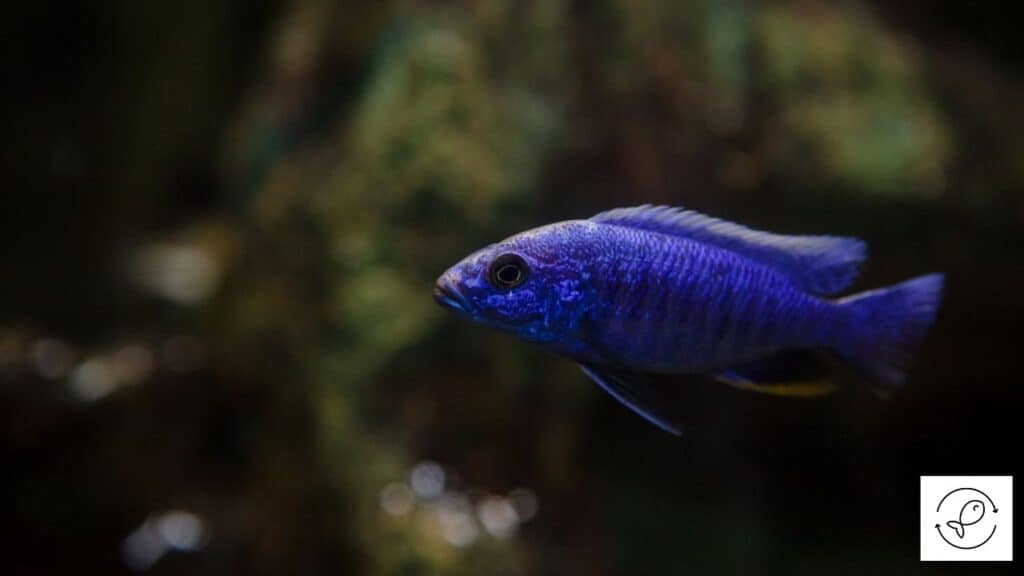
Cichlids tend to be quite diverse in their body shape, ranging from strongly laterally compressed bodies to cylindrical and highly elongated ones.
Cichlids usually range from medium to large sizes, are oval-shaped, and are slightly laterally compressed.
They’re usually similar to the North American Sunfish in morphology, behavior, and ecology.
Below are some features that distinguish them from other fish species:
- A single nostril for each side of the forehead rather than two.
- There is no bony shelf below the outer edge of the eye socket.
- The lateral line organ is divided into two parts. One is on the upper part of the flank, and the other is along the midline, from about halfway along its length to the base of the caudal fin.
Both the African and South American cichlids have stunning colors and patterns making them popular among aquarium enthusiasts.
Names of Species
Cichlids belong to the family Cichlidae in the order Cichliformes. This family is large and diverse.
There are at least 1650 species that have been scientifically described, making it the largest vertebrate family.
Given below is the list of cichlids classified based on their habitat.
| Habitat | Cichlid Species |
|---|---|
| Lake Malawi | Albino Peacock Cichlid, Acei Cichlid, Blue Johanni Cichlid, Blue Peacock Cichlid, Bumblebee Cichlid, Cobalt Blue Zebra Cichlid, Compressiceps Cichlid, Demasoni Cichlid, Electric Blue Cichlid, Electric Yellow Cichlid, Fuelleborni Cichlid, Kenyi Cichlid, Moorei Cichlid, Peacock Cichlid, Red Peacock Cichlid, Red Zebra Cichlid, Venustus Cichlid, Yellowfin Borleyi Cichlid, Yellow Peacock Cichlid |
| Lake Tanganyikan | Orange Leleupi Cichlid, Dickfeldi Cichlid, Brevis Cichlid, Marlieri Cichlid, Duboisi Cichlid, Calvus Cichlid, Tretocephalus Cichlid, Gold Sexfasciatus Cichlid, Caudopunctatus Cichlid, Moorii (Kaiser II) Cichlid, Cylindricus Cichlid, Frontosa Cichlid, Albino Ornatus Cichlid, Jeweled Goby Cichlid, Gold Head Compressicep Cichlid, Gold Ocellatus Cichlid |
| Other African Cichlids | Kribensis Cichlid, Buttikoferi Cichlid, Albino Kribensis Cichlid, Buffalo Head Cichlid, Nanochromis Cichlid |
| American and New World | German Blue Ram, Pink Convict Cichlid, Firemouth Cichlid, Black Convict Cichlid, Green Texas Cichlid, Bolivian Ram, Red Devil, Gold Severum, Green Severum, Jack Dempsey, Rainbow Cichlid, Assorted Apistogramma, Double Full Red Cockatoo Cichlid, Red Star Flowerhorn Cichlid, Panda Dwarf Cichlid, Surinamen Geophagus, Salvini Cichlid, Red Parrot, Port Acara, Green Terror, Tiger Oscar, Albino Oscar, Red Oscar, German Gold Ram, Managuense Cichlid, Peacock Bass, Double Full Red Agassizi Cichlid, Zebra Oscar, Texas Cichlid, Uaru Cichlid, Orange Cockatoo Cichlid, Black Stripe Dwarf Cichlid, Festivum Cichlid |
Lifespan
African cichlids can live between six to ten years.
In captivity, factors like a well-balanced diet, healthy environment, and tankmates play a significant role in determining a cichlid’s longevity.
However, studies have shown that captive fish tend to live longer than their wild cousins because they mature at a slower pace.
South American cichlids live longer than their African counterparts.
Depending on the species, South American cichlids can live between 10 to 20 years.
You can increase their lifespan by providing a healthy environment, keeping the water parameters stable, feeding a well-balanced diet, and offering calm surroundings.
Average Size
The size of cichlids varies depending on the species. The African and South American cichlids come in a mix of sizes.
The average size of African cichlids is 3 to 4 inches in length.
In contrast, the South American cichlids are mostly larger than their African counterparts.
Their average size is between 6 to 8 inches in length.
By providing the fish with protein-rich food, stable water parameters, and a healthy environment, you can ensure that they remain stress-free and develop overall.
Cichlid Tank Setup
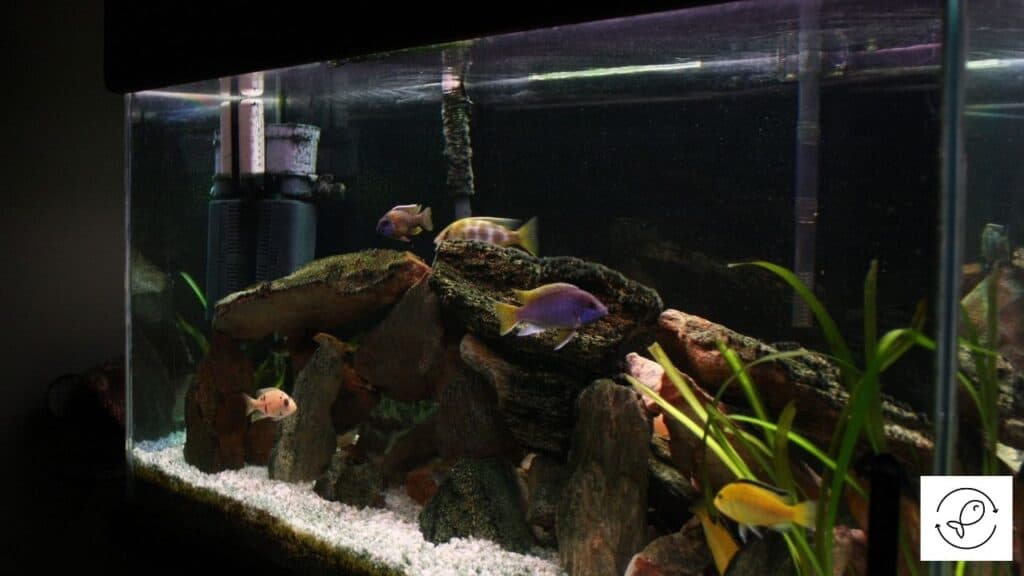
Cichlids are tropical freshwater fish. They prefer warm water, lots of swimming space, and dense vegetation.
So you need to create conditions that make cichlids feel happy and at home.
Let’s understand how to set up a cichlid tank in detail.
Tank Size
Cichlids need a lot of hiding places and dense vegetation inside their tank.
So while selecting a tank for cichlids, it’s essential to factor in the required hiding spots and open swimming spaces for the fish.
African cichlids need tanks of at least 30 gallons for four medium-sized or six small-sized fish, with an extra 5 gallons of water for each additional fish.
In comparison, most South American cichlids are bigger, and a 75-gallon tank is recommended.
For most other cichlid species, including the smallest ones, a 20 to 30-gallon tank is required.
Tank Equipment And Decorations
Most African cichlids are active and enjoy open waters and rocky substrate.
Small African cichlids enjoy exploring the crevices between rocks.
To keep rocks from falling on the fish, use aquarium glue to stick them together.
Use a soft, fine-grained sand substrate to prevent African cichlids from injuring themselves when searching for food.
South American cichlids are shy and need plenty of hiding places. Use driftwood, caves, and aquatic plants to create shelter.
In the absence of hiding spots, cichlids can get stressed and become aggressive.
Southern American cichlids need slow and steady water movement.
In contrast, cichlids from Africa don’t need as much water movement as cichlids from South American rivers.
Given below are the items required in a cichlid tank:
- Soft and sandy substrate,
- Heater,
- Filter,
- Aquatic Plants,
- Water Conditioner,
- Air Stones,
- Air Pump,
- Thermometer,
- LED Aquarium Lights, and
- Decorations like artificial rocks, caves, ornaments, driftwood, etc.
In addition, keep the temperature within the required range.
Create a natural environment for cichlids by setting up a tank that closely resembles their habitat in the wild.
Cichlid Care
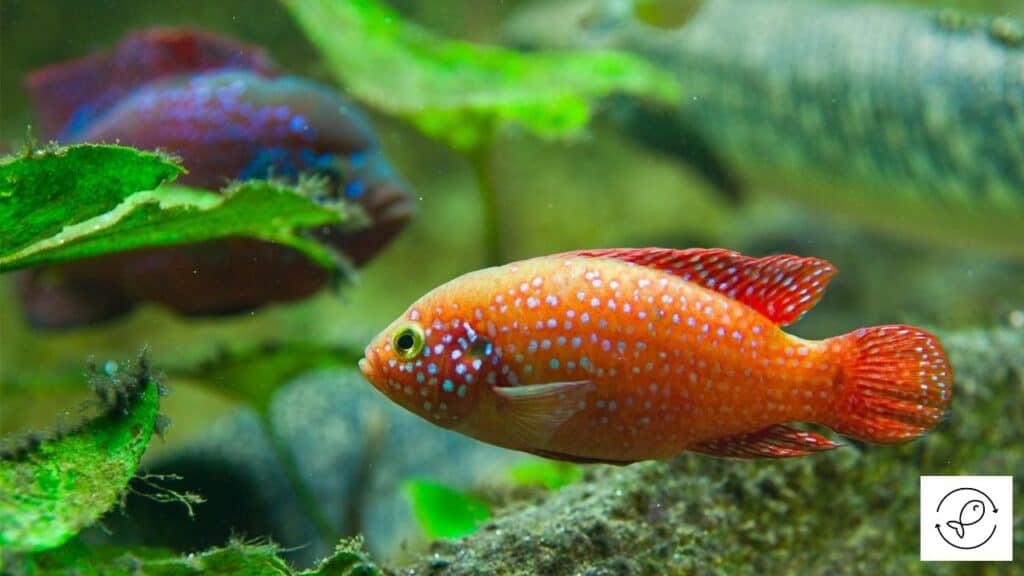
Cichlids are popular freshwater aquarium fish. Their stunning colors and varied patterns are captivating.
However, cichlids should be cared for based on their diet and habitat.
Diet
In the wild, cichlids eat various food depending on their habitat and dietary group. Herbivores eat algae, biofilm, and plants.
Carnivores feed on small wildlife and other fish, while omnivores feed on plants and small fish.
Herbivorous cichlids don’t eat a protein-rich diet.
In contrast, a protein-rich diet like small fish, bloodworms, crustaceans, invertebrates, planktons, and insects is required for carnivorous and omnivorous cichlids.
Manufactured fish food is usually affordable.
Algae wafers, flakes, pellets, and fish tablets are designed to provide adequate nutrition and enhance cichlid colors.
Live food is also nutritious and contains lots of protein.
Besides frozen food and fresh vegetables, you must plan their diet based on their dietary group to provide sufficient nutrition.
Some of the live food that you must feed your cichlids are:
- Bloodworms,
- Brine shrimp,
- Earthworms,
- Maggots,
- Mosquito larvae,
- White worms,
- Vinegar eels,
- Fresh Vegetables like broccoli, spinach, zucchini, squash, cucumbers, peas, etc.
- Fresh fruits like strawberries, blueberries, grapes, etc.
Cichlids tend to be greedy eaters.
So instead of giving them one or two big meals a day, give them three or four smaller meals throughout the day.
Feed them only what they can consume in 30 to 40 seconds or less.
This kind of feeding style will help the cichlids manage their aggression over the available resources.
Water Parameters
The water parameters for cichlid tanks will differ as per their natural habitat.
African cichlids prefer alkaline waters. On the other hand, South American cichlids tend to inhabit soft, more acidic waters.
The ideal water parameters for cichlids are:
| Water Temperature | 75°F to 85°F (24°C to 30°C) |
| Water pH | 7.2 to 8.6 (African cichlids), 6.0 to 7.0 (South American cichlids) |
| Water Hardness (dGH) | 4 to 8 (African cichlids), 2 to 4 (South American cichlids) |
Tank Maintenance
Cichlids need stable water parameters. An increase in ammonia levels will make the cichlids sick.
Poor water quality is usually the leading cause of head shaking in cichlids.
To maintain the water quality, you must install a sound filtration system to reduce ammonia.
You can also perform regular water changes to maintain water quality and high oxygenation levels.
Poor tank maintenance will make cichlids weak and susceptible to diseases.
At the same time, the fish can become extremely aggressive due to the underlying stress resulting from poor conditions.
Maintaining stable water conditions and a healthy environment is vital for the tank inhabitants.
Common Diseases
Cichlids are freshwater fish and need a healthy environment to thrive.
Irregular water changes and failure to remove leftover food will increase ammonia levels and make the tank water toxic.
So it’s essential to do a regular water change and clean the tank bottom to avoid fungal, bacterial, and parasitic infections.
Given below are some of the common diseases that can affect cichlids:
- White Spot,
- Ich,
- Malawi Bloat,
- Cotton Wool,
- Dropsy,
- Pooped Eyes,
- Gill Flukes,
- Camallanus Worm,
- Tuberculosis,
- Fungal infection,
- Fin Rot,
- Tail Rot, and
- Hole in the Head.
Regularly maintain your aquarium by cleaning out its filter and keeping the water clean.
It’s also essential to identify any signs of infection and separate the fish to avoid spreading it to other tankmates.
Cichlid Behavior And Temperament
Most cichlids are aggressive and can pose a challenge to their kind and other tankmates.
Territoriality is one of the reasons why cichlids fight each other. Cichlids usually perceive the aquarium as their territory.
So they will vigorously defend it by warning or threatening the intruders.
Food is the next thing that makes cichlids aggressive.
Cichlids continuously compete with other fish species for food in their natural environment, which is deeply ingrained in their behavior.
Males cichlids also engage in face-offs often to determine their social status.
It gives them complete control over their territory and the female fish for mating and reproduction.
Keep a ratio of two or three females for every male cichlid fish so that each male cichlid has the choice of several females.
This will help them to calm down.
Cichlid Tankmates
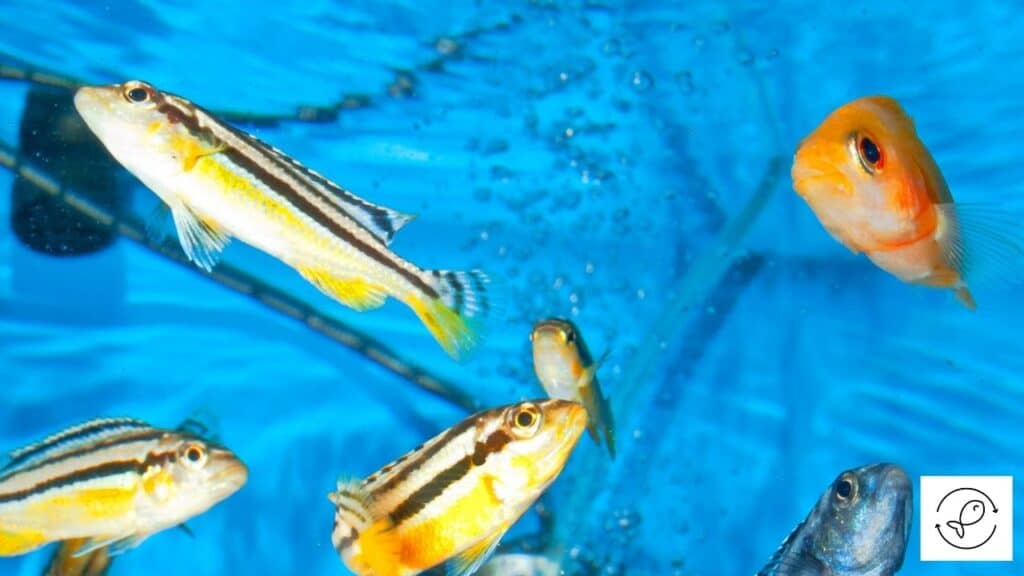
Cichlids are territorial and display aggression toward intruders while fiercely defending their territory.
So you must keep tankmates that can handle the aggressive behavior of cichlids.
The tankmates for cichlids should be similar in size and temperament.
They should be able to withstand the aggression without backing off.
You can also add large bottom dwellers that won’t intrude on cichlids’ territory.
Some of the popular tankmates that you can keep with cichlids are:
- Australian Rainbowfish,
- Dwarf Gourami,
- Flying Fox,
- Giant Danios,
- Pearl Gourami,
- Redeye Tetra,
- Red Tail Shark,
- Salmon Red Rainbowfish,
- Silver Dollar Fish,
- Clown Loach,
- Corydoras Catfish,
- Cuckoo Catfish,
- Leopard Bushfish,
- Leopard Catfish, and
- Otocinclus.
You must not keep fish with cichlids that are non-aggressive, docile, and peaceful.
Below are some types of fish that won’t survive with aggressive cichlids:
Cichlids aren’t schooling fish, but they like to swim around the tank.
So you must keep fish of the ideal size and temperament to deal with the aggressive cichlids.
Cichlid Breeding
Cichlid breeding isn’t challenging if you provide them with a healthy environment.
Male cichlids will shake or shimmer their bodies to woo females.
After pairing with the females, males carry them to their nests.
Once there, they will wait until the female cichlids are ready to spawn.
Then, the male will fertilize the eggs. Some cichlid species lay their eggs in the nest, while others are mouth breeders.
Mouthbrooders keep fertilized eggs in their mouth for several weeks until they hatch.
It’s a common way of breeding African peacocks, mbuna, and haps.
In contrast, South American varieties tend to lay their eggs on surfaces and guard them until they’re ready to hatch.
During this period, cichlid aggression will be at its peak to protect their young.
Females will take care of their young for two weeks before they go off to breed again, leaving the young to fend for themselves.
Young cichlids need a different diet than adults, as they eat small pieces of food until they get bigger.
Frequently Asked Questions
Do Cichlids Have Teeth?
Cichlids have tiny sharp teeth to scrape algae from the rocks. Conversely, carnivore cichlids have large fang-like teeth to help them grab the moving prey. Also, some cichlid species have pharyngeal teeth in their throat to help them crush and chew their food.
Are Cichlids Aggressive?
Cichlids are aggressive toward each other and other fish species. They constantly compete with other fish for food, territory, and mating rights in their natural habitat. Aggression is deeply ingrained in their attitude, and they often display aggression toward other fish, even in captivity.

